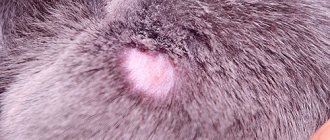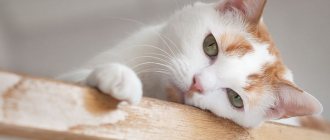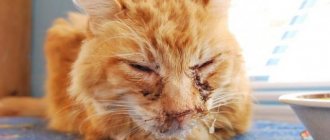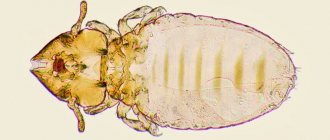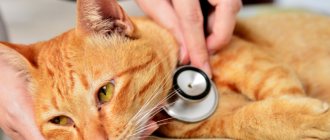Victoria Rashidovna Khazimulina
veterinarian Petstory
Our pets have to deal with such pathology as gastritis in cats. This disease is characterized by an inflammatory process of the stomach wall. Unfortunately, the first symptoms of gastritis can be mild; the pet often comes to the doctor at an advanced stage, when vomiting has begun or appetite has decreased. This happens because cats are very patient animals and it is difficult to tell if they are experiencing discomfort or pain. Therefore, it is very important to know how to recognize the signs of the disease, how to properly help your pet, how to treat gastritis in a cat, and how to prevent this disease in the future.
What is gastritis and what can it be confused with?
The pathology is an inflammation of the gastric mucosa, accompanied by a deterioration in cell regeneration and the proliferation of fibrous tissue. All this leads to disruption of excretory function.
The acidity of gastric juice deviates from the norm, up or down. In the first case, there is an increased risk of the formation of erosions and ulcers, and in the second - intoxication of the body against the background of rotting food stuck on the way to the intestines as a result of weakened motility.
The disease can be confused with its complication - an ulcer. Both pathologies are characterized by severe pain. But with ulcers, they appear almost immediately after feeding, often occur at night and worsen in the autumn-spring period.
Treats and additional feeding
If a cat with sensitive digestion is suitable for the food it receives, it does not need additional nutrition, vitamin supplements, and especially treats from the owner’s table. Moreover, such additives can have a negative impact on the cat’s digestive system. It is worth warning about this to household members who usually do not participate in feeding the cat, and to guests who come to the house.
However, cat owners often want to give their furry pet an extra bite or use a treat as a reward during training. In such cases, it is better to discuss the list of treats allowed for your cat and their permissible quantity with your veterinarian.
Reasons for the development of the disease
The causes of gastritis in cats are primary and secondary. In the first case, inflammation develops under the influence of external factors, and in the second, it acts as a complication of systemic pathologies.
External factors
Most external factors are associated with poor nutrition. Typical mistakes on the part of owners include:
- The temperature of the food being served is too high or low. Hot and cold pieces irritate the delicate mucous membrane. The condition is aggravated by rapid ingestion of food.
- Overfeeding. Failure to comply with the norms is fraught not only with obesity, but also with digestive disorders. The incoming volume of food does not have time to be digested by gastric juice, so the walls of the stomach stretch to store it.
- A sharp change in the usual menu. The transition to dry food and lower-class natural products is particularly difficult.
- Feeding food from the human table. Most of the foods we are familiar with are unacceptable for a cat's stomach, as they contain too many spices and additives. It is also not recommended to give your pet sharp bones and fish scales - they can cause mechanical injuries.
- Rarely changing water and neglecting its filtration. This is fraught with the consumption of harmful impurities and a high probability of infection by pathogenic microorganisms.
In addition to an incorrect diet, the inflammatory process can be caused by infections, helminthiases, poisoning and chronic stress. The disease can also be caused by long-term use of NSAIDs (anti-inflammatory drugs) and glucocorticosteroids. These drugs inhibit the synthesis of prostaglandins - special substances that protect the mucous membrane from the aggressive effects of gastric juice.
Internal factors
If inflammation develops against the background of another disease, then treatment will be ineffective until the root cause is eliminated. The most common systemic pathologies include:
- hormonal disorders;
- dental diseases;
- allergic reactions to food and medications;
- chronic renal and liver failure;
- diseases of the endocrine, cardiovascular and genitourinary systems.
There is also a genetic predisposition in some breeds. Such animals are at risk.
Risk groups and breed disposition
Pets prone to obesity and decorative breeds are most often affected. These include munchkins with unnaturally short limbs, Scottish Folds, short-tailed bobtails and hairless sphinxes.
The age of the animal also plays a significant role. In most cases, the disease is diagnosed in elderly individuals with weakened immune systems.
Types of gastritis
Gastritis is divided into exogenous and endogenous:
- exogenous occurs for external reasons, which are poor nutrition, food and chemical poisoning, and thermal factors. Most common;
- endogenous gastritis is the consequence of diseases of internal organs and disorders in the immune system. Cats have uremic, eosinophilic and hypoxemic gastritis.
The cause of uremic gastritis is disease of the kidneys and genitourinary system. In this case, the kidneys cannot cope with removing protein breakdown products from the body; they accumulate in the blood and become toxic. Uremia occurs, in which the level of urea in the blood is exceeded. From the blood vessels through the walls of the stomach, it penetrates inside and negatively affects the mucous membrane, causing its inflammation and subsequent degeneration of the stomach walls.
With the eosinophilic form, eosinophils accumulate in the mucous membrane, releasing substances that destroy the walls of the stomach. It happens with allergic diseases, helminthic infestations and oncology.
Hypoxemic type is a consequence of diseases of the cardiovascular system and lack of oxygen in the blood and cells.
Characteristic and uncharacteristic symptoms
The first alarming symptoms resemble a common cold or mild poisoning. A sick animal becomes lethargic and inactive. It tries to hide from people, as touching causes it pain. Because of this, good-natured pets show unusual aggression.
A sick cat eats very little or refuses feeding completely. Despite this, he can sit at his bowl for a long time, which indicates that his appetite remains intact. There is also increased thirst and a short-term rise in temperature.
After a few days, signs of gastritis in cats become more alarming. The existing symptoms are supplemented by:
- bilious or bloody vomiting, as well as regurgitation after each meal;
- significant loss of body weight;
- dulling of wool;
- diarrhea or constipation with pieces of undigested food in the excrement;
- putrid odor from the mouth and a grayish or whitish coating on the tongue;
- noticeable tension in the abdominal muscles and an acute reaction to touching the abdomen.
During acute attacks of pain, the animal spreads its front legs wide and lowers its head, maintaining this position for several minutes. If you notice at least one of the listed symptoms, your mustachioed pet should be taken to a veterinarian for examination as soon as possible.
How is acidity level determined?
The main acid found in the stomach and determining its acidity level is hydrochloric acid. It is produced by parietal cells. The alkaline components of gastric juice neutralize hydrochloric acid. They are produced by accessory cells of the mucosa. The two substances interact and the acidity level changes throughout the day.
You can find out its level using intragastric pH-metry. To do this, a thin probe with a measuring electrode is placed into the patient's stomach. It gradually moves deeper and shows the pH in different areas of the organ.
In the part of the stomach where acid is produced, in an adult patient the pH should be from 1.6 to 2.0, and in the zone of alkali production and acid quenching - up to 5.2.
The doctor also pays attention to the symptoms. With high acidity, the patient suffers from heartburn, belching and a burning sensation in the throat; with low acidity, the patient suffers from bloating, flatulence and bad breath.
Varieties of the disease
Symptoms and treatments for gastritis in cats depend on its type. The available types differ in the type of inflammation and secretion of gastric juice, the nature of tissue damage, the cause of occurrence and the form of development of the pathological process.
Classification by type
All the criteria discussed below are taken into account when making a diagnosis and drawing up a treatment plan. That is why you should not treat an animal on your own, based on the recommendations of friends and acquaintances.
By type of inflammation
In the presence of catarrhal, purulent or hemorrhagic fluid in the tissues and cavities of the body, the inflammatory process is classified as exudative. If, when the mucous membrane is damaged, cell death and extensive ulceration are noted, the disease is classified as an alternative type.
According to the type of gastric juice secretion
With low acidity, the variety is called hypoacid, and with increased acidity, it is called hyperacid. In rare cases, the secretion of gastric juice remains within normal limits. This type of pathology is called normicidal.
According to the nature of tissue damage
Only a limited area or the entire mucous membrane may be affected. The first type of disease is called focal, and the second is diffuse.
Due to the occurrence
Depending on the cause, there are 5 more types of pathology. These include:
- Endogenous
. Occurs when there is a deficiency of a number of microelements that impair the production of pepsin and hydrochloric acid.
- Hypoxemic
. Appears in cardiovascular pathologies accompanied by prolonged oxygen deprivation.
- Uremic
. Develops as a result of liver pathologies (ulcerative urolithiasis, pyelonephritis, chronic renal failure). As a result of protein metabolism disorders, the amount of urea increases sharply and irritates the mucous membrane.
- Eosinophilic
. It is diagnosed with an increased level of eosinophils - cells of the immune system, which is characteristic of allergies and parasitic infestations.
- Idiopathic
. It does not have an exact cause of origin, which complicates treatment and often leads to the development of ulcers.
It is also worth noting the lymphoplasmacytic appearance. It is less common than all the listed varieties and is classified as an autoimmune disorder. In this case, lymphocytes are responsible for irritation of the mucous membrane, attacking their own healthy cells.
Classification by shape
According to the form of development, gastritis in cats is divided into acute and chronic. In the first case, there is a rapid increase in pronounced symptoms, in the second - a sluggish course with a blurred clinical picture with periodic exacerbations.
Late detection of the acute form is fraught with its transition to chronic, which is very difficult to treat. For this reason, you should not rejoice at the attenuation of alarming symptoms. For real recovery, the pet requires mandatory medical care.
Reasons why gastritis develops in cats
There are many causes of the disease
.
If we talk about the acute phase, then it comes unexpectedly for both the owner and the cat. Sudden gastritis in a cat is provoked by hot dishes such as hot porridge, fish, meat, and so on. Also, cold food can cause pain and harm
to the gastric mucosa. If the animal was hungry and the food is consumed extremely quickly, this will only intensify the disease and traumatic consequences of the stomach.
In addition to such nutrition, there are a number of factors that are important to mention, because they also affect the condition of the body:
1
Anxiety and severe stress . For a cat, getting a dose of stress is not so difficult. Any loud noise or uninvited guest can trigger a panic attack. Therefore, you should not slam the door, turn on the TV loudly, or talk in a raised voice at inopportune times. If a guest comes, it is better to open the door for him in advance so that a sudden call does not frighten the animal. 2Cats may be predisposed to other chronic diseases. For example, liver or kidney can also cause the development of gastritis in a pet’s body. 3Many owners and unscrupulous cat owners feed the animal from the “common” table, thereby not only disrupting the cat’s diet , but also allowing harmful substances to enter the cat’s body. These include spices , spicy , fatty , smoked , food containing onions , garlic or other spices . This situation often happens with dogs. It is worth remembering once and for all that feeding any animal with “human” food is strictly prohibited . The cat should have a measured diet, which should include dry food and organic fresh food at the same time. The meat must be boiled without spices, otherwise there is a risk of causing gastritis and spoiling the animal’s sense of smell, which plays a huge role in its life. 4The quality of the feed must be monitored. It may be cheap in itself; the food may contain many harmful fats that are contraindicated for your pet. Food can deteriorate and become stale, this also needs to be monitored. After all, similar cat food can cause not only gastritis, but also a number of other diseases that will negatively affect the body. 5It is worth monitoring the activity of the animal’s life . In addition, you should not overfeed
your pet.
Cats of many breeds are prone to obesity, and given that most of them spend 90 percent of their time indoors, the risk is even higher. After eating, which should be portioned and not too large in volume, the animal needs to rest for a couple of hours so that the food is absorbed. After this, you need to play with the cat, for example, using a laser pointer or a ball with a ball. Each cat has its own preferences and they must be satisfied every day to avoid obesity and maintain the pet’s muscles. 6Not only people have allergic reactions to various allergens and components. Cats are also prone to such deviations, which means you should be careful. The Ya-Vet veterinarian is able to conduct a number of express tests that will help identify abnormalities and allergens that should be avoided
.
7The animal has a risk of developing worms and other parasites in the gastrointestinal tract. Their unfavorable activity can cause gastritis in a cat at any age. 8All cats, unless they are Sphynxes, lick fur, which enters the stomach in large quantities. Sometimes it happens that hair accumulates in a cat’s stomach ; various factors are associated with this and there are different ways to combat this phenomenon. However, it is important to monitor the amount of fur regurgitated , and if there is too little of it than before, or even none at all, then you should sound the alarm. This develops a number of diseases, which include the mentioned gastritis. 9Some medications may be poorly absorbed by cats.
Some components can, for example, be allergens and so on. This means that you should be careful when choosing medications. Only a veterinarian who knows which components can be potentially dangerous can do this. If such a medicine needs to be taken, the veterinarian conducts tests and diagnostics, after which he determines whether such drugs can be given to the pet or not. As you can see, there are quite a lot of reasons and it is difficult to say which of them are more common and which are less common. All the causes listed here mean they occur regularly in cats around the world
, which means this disease can overtake your cat. To avoid this, you need to carefully monitor the symptoms, and also know the basics of the disease in order to understand what you are facing and why it is so important to call a veterinarian at home.
Forms of gastritis in cats
At the beginning of the article, we already mentioned the presence of acute and chronic forms of gastritis in cats . However, there are other forms and types that must be taken into account and kept in mind. Let's look at them:
1Acute gastritis is quite sudden and transient. If you imagine the mucous membrane, it will look red and swollen. A deviation occurs which is called secretion. It does not allow food to properly react with gastric juice. Because of this, food inside the stomach ferments, decomposes and rots, rather than being digested. This means that the resulting gases and toxins poison the cat’s stomach and body, which leads to an acute form of gastritis. Next, let's look at the main symptoms of the disease in general. 2Chronic gastritis leads to the following disorders in the stomach: gastric juice is not formed in the required quantity (lack or hypersecretion). The mucous membrane becomes sore, blood vessels collapse, which often results in internal bleeding, which is extremely dangerous for the animal. 3Gastritis can be uremic; it develops due to kidney disease. The kidneys are not able to cope with the load and the body is poisoned with protein. Thus, urea is formed and accumulates in the gastric juice, hence uremic gastritis. 4There is eosinophilic gastritis, which appears extremely rarely in cats, but it cannot be ignored. It develops due to allergens, low-quality medications, or low-quality food with dyes. Inflammation of the stomach occurs due to the accumulation of eosinophils in the mucosa. Eosinophils are blood cells that develop and appear during allergic reactions.
It is worth mentioning gastritis with high acidity , with low or stable normal acidity. This is an important aspect in the treatment of gastritis in cats, which the doctor must know for correct and competent treatment.
Symptoms and signs of gastritis in cats
Acute gastritis has individual symptoms that need to be mentioned. It is worth understanding that they are similar to chronic, which we will talk about later, but chronic has its own specific treatment. So,
- Acute gastritis includes the following symptoms:
- The animal loses the desire to eat, the appetite disappears almost completely due to the pain that the pet experiences. Sometimes he sits in front of a bowl and wants to eat, but realizes that this will cause nausea and pain.
- The next symptom is nausea and severe vomiting, as well as regurgitation of food. Nausea can occur suddenly even an hour after eating. Regurgitation occurs almost immediately after eating; this is observed during the most acute phase, which is due to the fact that the owner did not see the symptoms earlier.
- Since the digestion process is disrupted, fragments of food that the animal has eaten are visible in the animal’s feces. This is a bad sign, which means that the pet does not receive any nutrients from food, which means the immune system deteriorates and weakens. Weak immunity can attract infections and diseases, which are not so easy to treat simultaneously with gastritis.
- The disease manifests itself in the form of diarrhea and diarrhea, and sometimes constipation.
- The cat itself becomes apathetic. Often you can see her lying in a secluded corner, she does not make contact and does not want to play. This is a typical symptom for almost all cat diseases. She tries to avoid contact and sometimes even becomes aggressive. After all, the cat is in pain and does not understand that the owner and the veterinarian want to help her.
- If you look at your pet's muscles, you can see that they are tense due to pain. She herself, as has already been said, does not give in and does not want to make contact. This complicates the treatment process, because any examinations and diagnostics, especially by a stranger, are perceived aggressively. This is another reason to say that taking your cat to the veterinary clinic on your own is not an option. Because then she will experience even more stress.
- The cat's tongue and other mucous surfaces become pale or completely yellow. A painful whitish coating is visible on the tongue itself.
- Gastritis can be determined by the condition of the coat. Indeed, in the acute form of the disease, the fur becomes dull and faded.
- A musty clay smell comes from the animal's mouth.
Next, let's look at the signs of chronic gastritis in cats , which is not easy to cure.
How does chronic gastritis manifest in cats?
The manifestation of gastritis in the chronic form occurs in waves: it fades and appears every other time. The symptoms generally coincide with acute gastritis, but they appear every once in a while and there is not always a chance to catch them. It’s so easy to confuse gastritis with a simple indigestion. Such attacks appear and last for several days.
, and
sometimes several hours
, but on an ongoing basis. The owners are in vain to believe that if the disease and symptoms cease to appear on their own, then the disease is defeated. Of course, this may be so; the immunity of animals and people sometimes works wonders. However, most likely the disease has become chronic, which is not very good in itself.
How to diagnose gastritis in cats
To correctly diagnose gastritis , the veterinarian needs to use not only experience, but also the following examination methods:
- Standard examination of the animal, palpation.
- Anamnesis collection.
- Express analysis of urine.
- Express blood test.
- Ultrasound of the gastrointestinal tract.
- Determination of the amount of gastric juice.
If the situation has become severe, then the following diagnostics are used:
- X-ray.
- Biopsy
- Endoscopic methods.
How to treat gastritis in a cat
Treatment with folk methods or remedies that were read about on the Internet is strictly prohibited . This can only aggravate the situation and harm the animal. Often acute attacks of gastritis can be cured by fasting for 24 hours, but only after the recommendation of a veterinarian. Your cat should only be given boiled water to drink.
Such a hunger strike is followed by
the next stage of treatment,
when the animal is given decoctions based on flax seeds, rice
and other similar products that normalize the state of health. After all, it is strictly forbidden to return suddenly to the usual format of food and feed. This is a gradual and slow process during which the animal must adapt.
Cats can vomit for a very long time, so veterinarians prescribe anti-nausea medications . However, only experienced doctors can calculate the dosage and course of use.
. An ordinary person will never be able to do this competently without harming the animal. Moreover, sometimes the cat’s stomach acidity increases, which means that other remedies are given.
In addition to anti-nausea medications, medications are given that coat the stomach from the inside. Sometimes juice from vegetables such as cabbage or beets is given. Decoctions made from oak or St. John's wort are popular. This is considered a folk remedy, but its use is allowed only after the recommendation of the attending physician.
In the acute phase, during which gastritis becomes bacterial in nature, antibiotics . Sometimes infusion therapy is used, which flushes toxins out of the body through flooding.
Carrying out diagnostics
Due to the similarity with a number of diseases, a mustachioed patient will have to undergo a number of mandatory studies to make a diagnosis. These include:
- biochemical tests of urine and blood, determining the presence of urolithiasis, chronic kidney and liver failure, as well as stomach acidity;
- endoscopy and biopsy of the stomach, assessing the condition of the mucous membrane and the amount of gastric juice;
- Ultrasound and x-rays that reveal abnormalities in the functioning of internal organs.
After receiving all the results, the doctor decides how to treat gastritis in a cat, starting from the root cause. Therapy is based on medication and nutritional changes.
How to diagnose gastritis?
To make an accurate diagnosis, the cat must be shown to a doctor. The veterinarian will be able to determine which pathological condition of the animal’s body he is dealing with and prescribe the correct treatment based on:
- medical history (the owner must provide this data, that is, tell about all the unusual signs that he observed in his pet);
- clinical picture;
- laboratory studies of gastric contents.
Additionally, tests for viruses, bacteria, and microscopic fungi may be required to exclude the infectious nature of gastritis.
Basic principles of treatment
Treatment of gastritis in cats at home is possible only after the condition has stabilized. In severe cases of the disease, the mustachioed patient is left in the hospital for several days for infusion therapy (drips). After eliminating the vomiting attacks and restoring the water balance, the pet is returned to the owner.
Depending on the symptoms present, the following medications may be needed:
- antiemetics (Metoclopramide);
- antiulcer drugs (ranitidine, omeprazole), which reduce acidity levels;
- digestive enzymes (Trypsin, Mezim-Forte, Pepsin);
- antibiotics (Sinulox, Kefzol, Ampicillin);
- analgesics (Spazgan, Baralgin);
- antacids (Phosphalugel, Almagel), enveloping the irritated mucosa;
- glucocorticosteroids (Prednisolone), which relieve allergic reactions;
- vitamins and immunomodulators.
To protect nerve endings from irritating factors, it is recommended to drink decoctions of oak bark, St. John's wort, flax seeds and blueberries, which have an enveloping effect. Please note that turning to traditional medicine is allowed only as part of complex therapy and only as prescribed by a veterinarian.
What to feed a cat with gastritis
Diet is the first thing to consider during the treatment of gastritis, as well as after it. In principle, diet is very important in the life of any animal. Only a balanced diet can save your pet from many abnormalities and diseases, minimizing the risks.
As already mentioned, it is not recommended to feed the animal in the first 24 hours . The only thing the animal is allowed to take is boiled water . After this, gradual feeding of ground food occurs, but the quantities are very concentrated and small. Gradually give chicken or turkey, which has been boiled without spices. Total food intake should be no more than five per day; as prescribed by the doctor, they range from three to five.
If the cat's acidity is low , then give porridge, cottage cheese, and drinking boiled water.
If the cat's acidity is high , then feed it lamb, chicken, turkey or fish, which is boiled.
There are situations when an animal does not want to eat food and agrees only to ready-made food to which it is accustomed. Then it is worth discussing separately with your veterinarian which foods should be given to the animal and which ones will not harm the gastrointestinal tract. There are types of food that are given to animals only for gastritis. There are both canned and dry types of food. It all depends on the pet’s personal preferences and the veterinarian’s recommendations.
Diet is the most important part of therapy
The pet will have to fast for 24 hours after diagnosis. The next day, he should be gradually transferred to a therapeutic diet or dry food designed specifically for cats with gastritis.
You need to feed often (3-5 times a day), but in small portions. All food should be ground and pureed to a puree state, and its temperature should be at room temperature. When dry feeding, the granules will have to be soaked in water, but you can simply use soft canned food from the medicinal line.
The list of permitted products is determined by acidity:
- increased
– boiled meat, slimy porridges, low-fat fish, potato and carrot juices;
- reduced
– fermented milk products, bean puree, eggs, light soups with fish or meat broth, beetroot and cabbage juices.
Handouts from the human table should be completely eliminated. It is also recommended to ensure sufficient quantity and purity of water.
Can healthy cats be given food for cats with sensitive digestion?
Veterinary diets, which are prescribed by a veterinarian, serve to alleviate the condition of the animal during the treatment process. These foods are not intended for continuous feeding. In contrast, food for cats with sensitive digestion can be used as the main diet for an extended period of time.
Such food will not harm a healthy animal. However, when feeding it, you should remember that food for cats with sensitive digestion is highly nutritious. Their recommended serving size is smaller than that of basic diets. At the same time, they have an attractive taste and smell for cats. A cat that is accustomed to a certain portion size may begin to overeat and gain excess weight if given free access to food for cats with sensitive digestion.
It is also necessary to take into account the recommendations of the food manufacturer regarding the age, physiological state and physical activity of the cats for whom the food is intended.
Different age groups of animals require different ratios of essential nutrients and the content of vitamins and minerals in the feed. Cats that have other special needs in addition to sensitive digestion may also need food that differs in composition from the basic one. Complete foods, the recipes of which were developed by experts in the field of pet nutrition, allow you to choose the optimal diet for each cat.
A variety of diets for cats with sensitive digestion are available, for example, in the PRO PLAN® food line.
PRO PLAN® DELICATE FOR KITTENS WITH SENSITIVE DIGESTION, WITH TURKEY, is rich in high-quality, easily digestible protein and also contains all the vitamins and minerals necessary for the proper growth and development of the kitten.
PRO PLAN® DELICATE FOR ADULT CATS WITH SENSITIVE DIGESTION, WITH TURKEY contains all the ingredients necessary for long-term, complete nutrition for an adult cat. It also contains a special formula that helps maintain kidney health.
PRO PLAN® STERILISED FOR STERILIZED SENSITIVE CATS WITH CHICKEN helps cats maintain a healthy body weight thanks to its high protein content (41%) and low fat content (12%). The harmoniously increased fiber content allows the cat to feel full faster and prevents constipation. The balanced composition of the food helps maintain the health of the urinary system in sterilized cats and reduces the risk of developing urolithiasis.
All of these foods are highly palatable to cats and contain the OPTIDIGEST® formula, which helps support digestive health with natural prebiotics.
Prognosis and complications
With timely treatment, the prognosis is favorable. Exceptions include lymphoplasmacytic, eosinophilic and uremic gastritis in cats.
The first 2 types often recur, and the 3rd type is incurable in the presence of chronic renal failure. Chronic gastritis is no less difficult to treat.
Despite this, even the onset of a prolonged remission will be successful. You should not refuse drug therapy, since an advanced pathological process can result in the development of ulcers, loss of teeth, deterioration of vision and hearing, excessive hair loss, intestinal obstruction and gastric hemorrhage.

